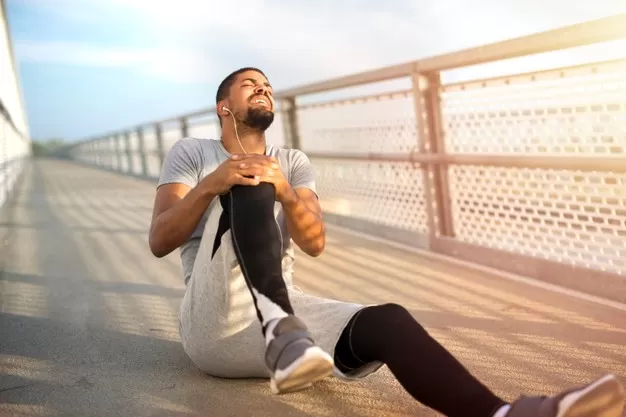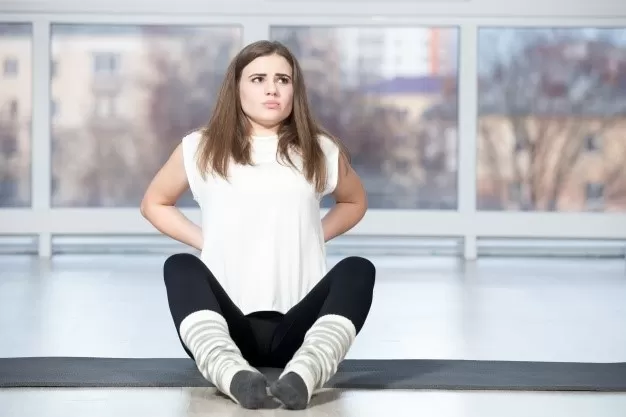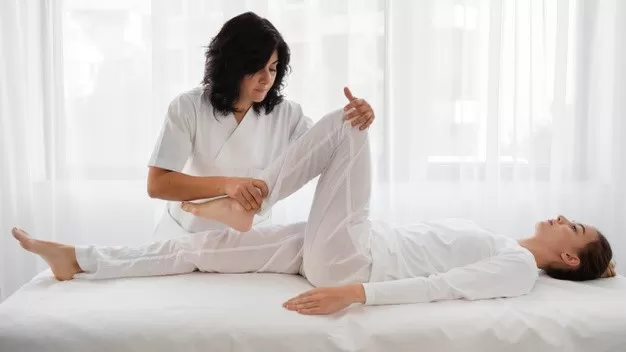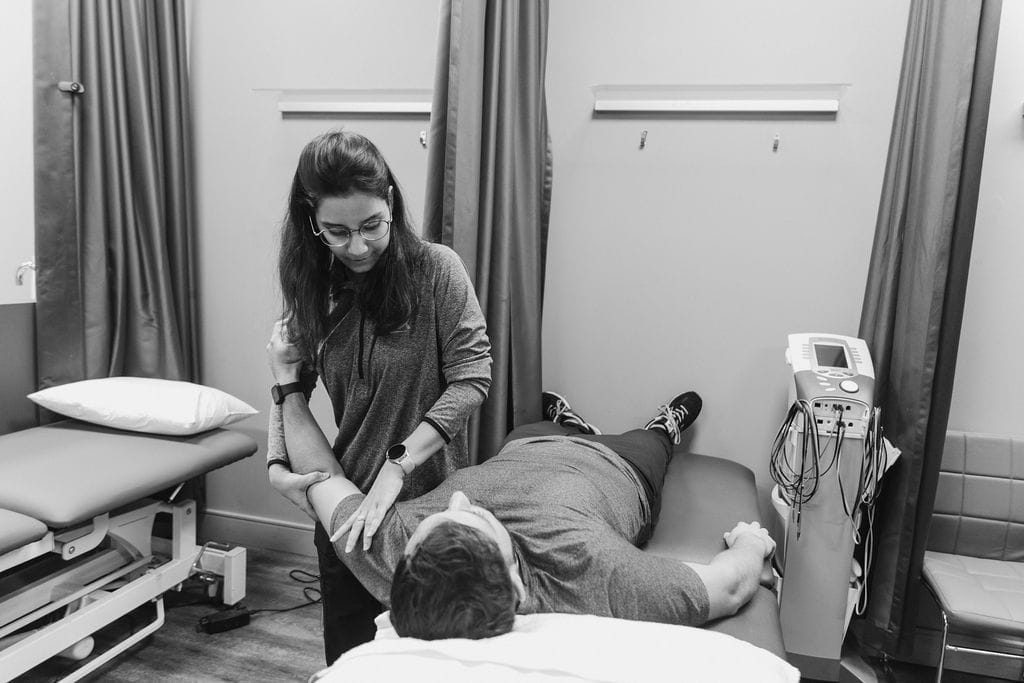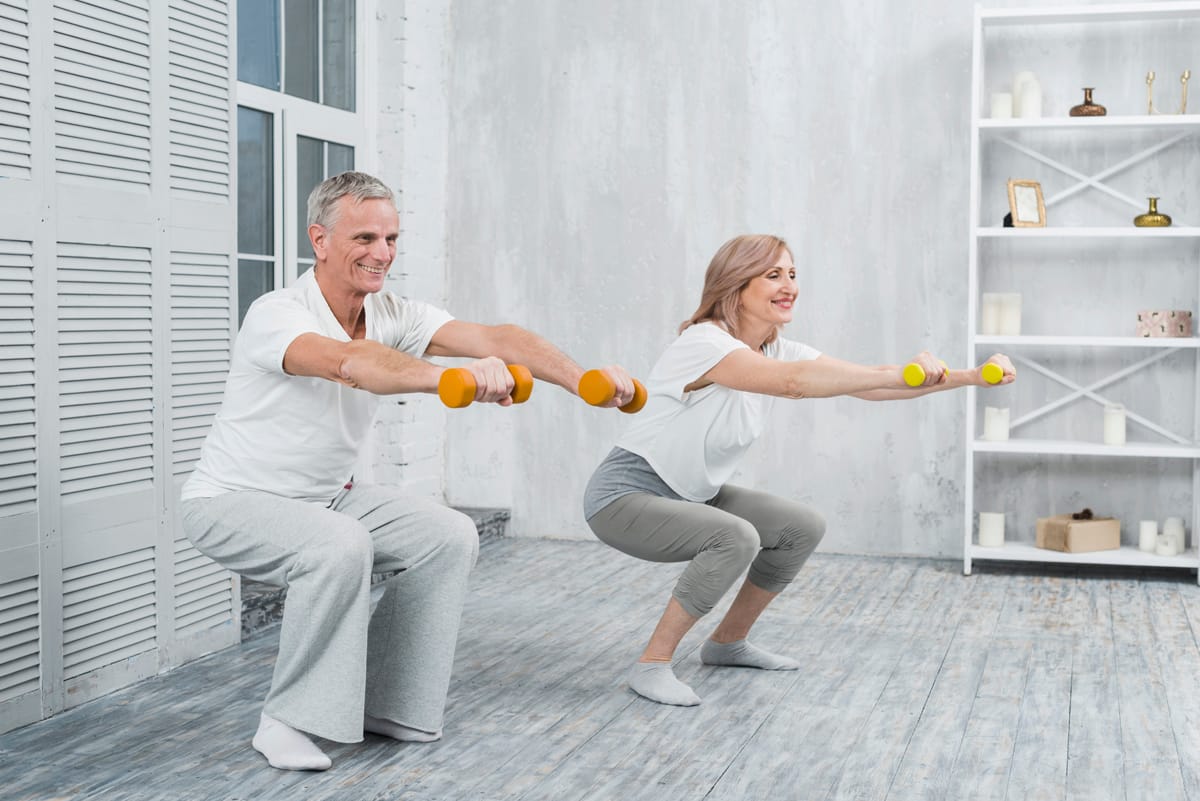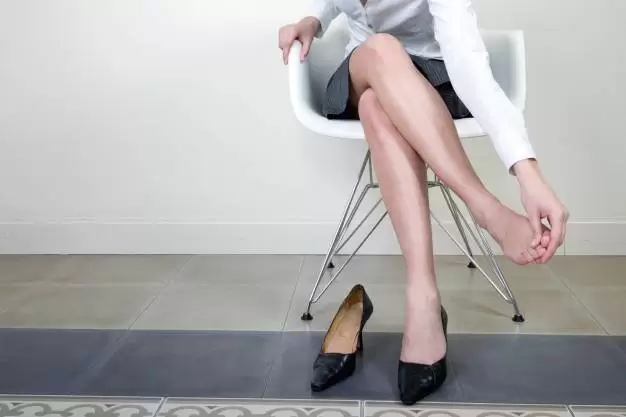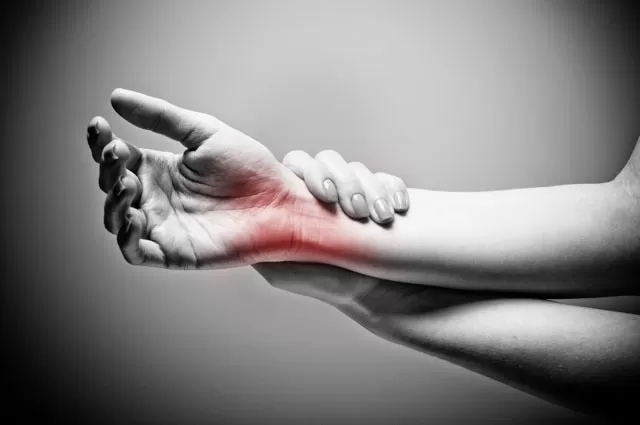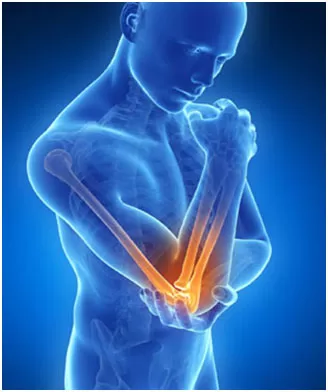Physiotherapy and Physiology both have many similarities, but they have a set of differences too.

What is Physiotherapy and what does a physical therapist do?
Physiotherapy or Physical Therapy is a medical treatment where patients face problems of mobility, function, and well-being; pain in specific locations of a body especially body parts that are in constant motion like bones, tissues, etc. it helps through physical rehabilitation, injury prevention. Tests are carried out to determine the limitations of the patient which further helps in formulating the set of exercises that will aid in restoring movement.
Physiotherapist duties are:
- Detect the patient’s medical issues in order to help the patient recover from illness, accident, or injury.
- Provide a clear and well-organized exercise program with clearly defined goals and milestone targets.
- Set objectives for patient progress and document it.
- Set up an exercise session as a part of the treatment, and maintain detailed reports of future exercise planning.
- Prepare an evaluation document, and instruct patients to use exercise equipment such as walkers.
- Inform the patient about the benefits of exercise to mentally motivate them.
- Follow the doctor’s directions to prescribe exercises meanwhile assisting doctors and nurses if required.
What is Physiology and what does a Physiologist do?
Physiology is a medical treatment and a detailed study of the anatomy of the body’s organs and their cells, this treatment aims at preventing chronic diseases and providing physical health benefits suffering from injuries. It treats diseases like obesity, cardiovascular diseases, and diabetes.
Physiologist responsibilities are:
- Monitor and record patients’ health and medical performance while exercising and under medication, and make thorough observations over time to deliver results to the physician.
- Use medical equipment and machinery when going through the exercise of the lungs and heart.
- Performing tests to evaluate physical and mental stress levels.
- Simultaneously work with physiotherapists to evaluate results.
- Create a plan of types of exercises to be followed.
- Assess the treatment’s effectiveness to fetch the right results.
Differences between Physiologist and Physiotherapist
- Physiologists and exercise physiologist degree requirements both undertake 4 years of university training, both theoretical and practical, studying subjects such as anatomy, physiology, and biomechanics, etc. Both are recognized by Medicare, TAC, WorkCover, and private health funds, and require yearly professional development.
- Physiologists provide prescriptions and teach trigger point therapy and self-massage techniques, using exercise equipment such as foam rollers and trigger point balls. Physiotherapists, on the other hand, can deliver soft tissue mobilization through massage, acupuncture, dry needling, and ultrasounds, and guide you through self-massage techniques as well.
- Physiotherapists evaluate the injury diagnosis and prognosis, whereas Physiologists receive the injury diagnosis and deliver the rehabilitation prognosis.
- Physiologists specialize in providing lifestyle modification techniques to support those with a wide range of chronic health conditions to promote improved health and wellness and decrease risk. Physiotherapists will overall specialize in the acute phase of an injury, and can often also deliver long-term rehabilitation and health monitoring.
- Exercise physiology accreditation and the conditions they work with:
- Cancer treatment recovery
- Chronic pain and fatigue
- Managing osteoarthritis pain
- Osteoporosis and arthritis
- Diabetes
- Metabolic Syndrome
- Mental health
- Musculoskeletal
- Neurological (Parkinson’s disease, multiple sclerosis, cerebral palsy)
- Obesity
- Pulmonary
- Cardiovascular
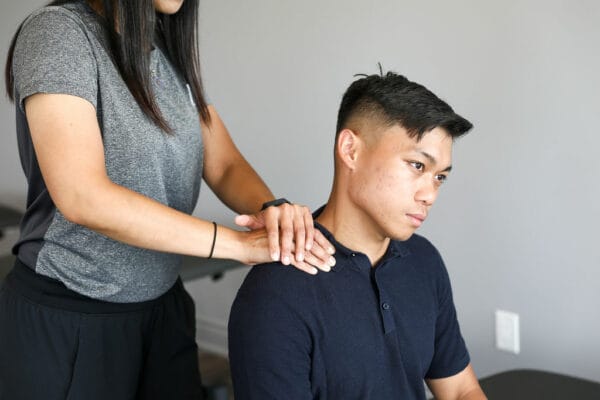
6. Conditions physical therapists work with:
- Mobility and balance concerns/falls
- Back or other spinal joint pain
- Sports injuries
- Chronic pain
- Post-surgery rehabilitation
- Cardiorespiratory issues
- Neurological (injuries) conditions – for example, stroke
- Parkinson’s disease
- Multiple Sclerosis
- Arthritis- for example osteoarthritis/rheumatoid arthritInjury Cycle – Acute Phase
Injury Cycle – Recovery Phase
The next phase of rehabilitation that is 3 to 4 weeks post-injury, is when a Physical Therapist will come into the play and provide treatment in order to introduce exercises to regain range of movement, including mobilization of soft tissue structures, and restore joint mobility and strength to optimize function.
All exercises prescribed by the Exercise Physiologist are made to achieve each individual’s activities of daily living and rehabilitation or performance goals.
Exercises recommended by Physical Therapists are made to achieve an individual’s daily life activities and rehabilitation or performance targets.
Difference between Physiology and Physiotherapy
| Physiotherapy | Physiology |
| Disorders concerning muscle and bones are treated by physiotherapy. This includes some medical conditions such as arthritis, joint aches, back pain, cardiorespiratory ailments like emphysema, asthma, neurological disorders like Parkinson’s disease, stroke, and post-surgery complications, etc. | Physiology focuses on increasing metabolism and physical energy during the course of treatment along with rehabilitation. The diseases treated by physiological exercises are obesity, hypertension, diabetes, immunity complexities, arthritis, etc. |
| The techniques used by Physiotherapy are manipulation, electrotherapy, mobilization, therapeutic physiotherapy exercises, and gentle massage. These are performed by trained physiotherapists after evaluating the patient’s physical conditions. | Physiological treatments are not rendered after identifying the problem. The treatment to lower any kind of discomfort before a proper diagnosis is a part of physiology exercises. In physiology, a proper plan is designed with the mainstream treatment and changes in lifestyle and behavior. |
| Physiotherapy can be studied at the Bachelors’s level (BPT) course. | Physiology is a higher academic course at the Post Graduate level of medical science. One has to complete MBBS before opting for MD in Physiology. |
Why do you need a Physiotherapist and how can they help you?
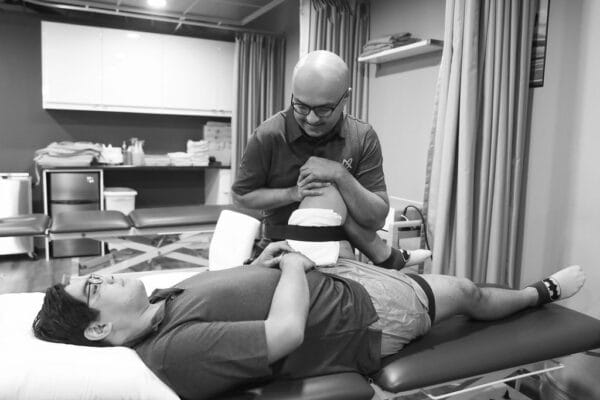
Using these checklists is a great way to decide which health professional is best for you.
- Do you have pain that is new, unexpected, or not yet diagnosed?
- Or you have a type of sports injury, or have you recently undergone orthopedic surgery?
- Do you require hands-on treatment for symptomatic relief such as acupuncture, manipulation or massage?
If you have answered yes to any of the above questions, then a Physical Therapist may be for you!
It’s well known that exercising for the proper duration and intensity may help improve the quality and length of life – it may decrease the incidence of obesity and chronic health conditions. Accredited Exercise Physiologists can work with such conditions through prescriptions and proper training.
Our Exercise Physiologists are university-qualified health professionals who provide safe, effective exercise programs, tailor-made to meet your health goals.
Do you need a physiologist and a physiotherapist and how can they help you?
Using these checklists is a great way to decide which health professional is best for you.
- Are you recovering from an injury, or have a prior injury that you do not want to worsen, however, wish to get fit and healthy?
- Do you have a chronic health condition (such as diabetes, hypertension, high cholesterol, asthma, obesity, osteoporosis, etc.) that exercise could assist with?
- If you have goals around losing weight or maintaining a healthy weight?
- Do you seek a specifically drafted and prescribed exercise program that will meet your health and wellness needs?
At the end of the day, there is a degree of overlap between both professions as they aid in treating many different conditions and aspects of health and well-being. The key takeaway is to choose the right professional based on your stage of recovery. If you are in the acute stages of rehabilitation, a physiotherapist is the ideal person to seek treatment from. However, if you are in the sub-acute, recovery, or chronic stage of rehabilitation, receiving treatment from an expert physiologist who can provide a specific and individually tailored exercise program is what you need.
At Physiotherapy Oakville, our team collaborates with both physiotherapists and physiologists to ensure you receive comprehensive care at every stage of your recovery. Scientific evidence supports the importance of tailored treatment plans in achieving optimal health outcomes. By joining Physiotherapy Oakville, you benefit from a multidisciplinary approach that addresses your unique needs, ensuring effective treatment and a smooth recovery process.
Click HERE to book an appointment with a physiotherapist at one of our eight locations.
- Physiotherapy Etobicoke – Triangle Physiotherapy Etobicoke
- Oakville Physiotherapy Clinic – Triangle Physiotherapy Oakville
- Physiotherapy North York – Triangle Physiotherapy North Yor
- Mississauga Physiotherapy Clinics – Triangle Physiotherapy Mississauga
- Downtown Physiotherapy Clinics – Triangle Physiotherapy King West
- Uptown Physiotherapy Clinics – Triangle Physiotherapy Lawrence Park
- Physiotherapy Clinic Downtown Toronto – Triangle Physiotherapy Queens Quay
- Physiotherapy Clinics Mississauga – Triangle Physiotherapy Erin Mills
“Understanding the differences between a physiologist and a physical therapist is crucial for choosing the right care for your needs. Triangle Physiotherapy offers expert services across the GTA, including Physiotherapy in Etobicoke, Oakville, North York, Toronto, Lawrence Park, Queens Quay, Erin Mills, Mississauga, and Liberty Village. Our skilled physiotherapists are here to provide personalized treatment plans tailored to your specific health goals.”
When it comes to patient care, it is important to understand the different severities of injuries. This classification is important as it helps the medical practitioners to address and prioritize the efforts. Here, we are going to talk about the difference between injury and trauma and help you understand how does physiotherapy help in the treatment of both.
Unfortunately, the injuries caused due to trauma are very severe and require need complex medical treatment and longer recovery time. Therefore, anyone who undergoes a traumatic injury must consult the experts for their condition and avail the best physiotherapy treatment to ensure maximum and fastest recovery.
What is an injury?

What Is An InjuryIn simple terms, any instance that causes harm to the body can be classified as an injury. Injuries can be divided into different ranges, depending upon the severity and impact on the body. Some injuries might require immediate medical attention while some can heal naturally with minimum or less care. Some examples of injuries are cuts, burns, scrapes, minor concussions, broken bones and sprains. What may look like a minor injury could require urgent and special medical care. Therefore, it is suggested to visit a trained and experienced physiotherapist or practitioner in case of an injury.
What is a trauma?
Trauma can be explained as a more serious, possibly life-threatening injury, requiring urgent medical attention. A trauma is a critical injury and therefore most hospitals have a trauma center to attend and treat sensitive and urgent cases like these. Some of the examples of the trauma includes road accidents, severe cuts, burns, blunt-force trauma, serious falls, multiple broken bones, head injury, major concussions or stab wounds. Though the minor cuts or wounds can be handled by an effective first-aid kit or stitches, serious trauma like burns, bleeding artery or head injury may require extensive surgery followed by rehabilitation for a proper recovery.
Physiotherapy and Injury
When it comes to the recovery stage, physiotherapy is extremely beneficial. Many people believe that the road to recovery in injury passes through physiotherapy and the recovery can never be complete without physiotherapy. If a person has suffered from an injury from a broken bone or a sprained limb, he will face major challenges in routine activities. Simple tasks like walking or driving can be become arduous. This is where physiotherapy comes into picture. Physiotherapy provides the direction to exercise and mobilize specific muscles and tissues so that the body heals from the injury.
If a person suffers from an injury – major or minor, it is suggested that he should consult with the doctor about the recovery plan that must include physiotherapy. It is important to note that even a minimal physiotherapy helps in regaining strength and functionality post the injury. Injury recovery is not possible with a focused and dedicated physiotherapy program. For cases involving broken bones or sprains, physiotherapy is very useful to stretch and comfort the affected area and expedite the healing. Preventive physiotherapy is also beneficial for elderly patients and people at risk of injury. It helps in ensuring and maintaining balance, strength, agility and a complete range of motion while preventing injuries.
Physiotherapy and Trauma
Trauma injuries usually require more extensive and immediate surgery to fix the damage. Traumatic cases have extensive long recovery process. Patients suffer mental and physical anguish in injuries involving surgery. Based on the extent and severity of the injury, the recovery process may be anywhere from a few days to several years. In some unfortunate cases, some patients are never able to recover despite optimal surgery.
The time immediately after the injury and the subsequent surgeries is the most crucial one for people who have suffered a big physical trauma. It is this period that plays one of the biggest deciding roles in the duration and pace of the recovery. Therefore, it is suggested to consult an experienced and trained medical practitioner for the injury. Based on the injury and medical history, the doctor/medical practitioner prepares a recovery plan which starts immediately and involves a comprehensive active recovery like physiotherapy. Physiotherapy can be a painful and difficult process, but helps in regaining strength and mobility post traumatic injuries. They are a part of the recovery process in complicated cases like brain injuries and physical trauma.
Physiotherapy in GTA
Physiotherapy and rehabilitation care services can come in various forms based on the severity of the injury and medical history of the patient. For example, someone suffering from Tennis Elbow or Stress Fracture may need Shockwave Therapy Treatment, while someone who gets a head injury might need Vestibular Rehabilitation to cure dizziness and provide stability and balance to the mind. It is important to know that every situation is unique in its own way and therefore needs a different recovery plan and timeline. That is why one should be patient and adhere to the recovery plan chartered by the physiotherapist to get optimal results. At Triangle Physiotherapy, we offer a host of services aimed to provide relief from the pain and ensure preventive care for overall strength and well-being. Some of our services include –
- Pelvic Floor Physiotherapy – To encourage patients to successfully treat pelvic issues
- Vestibular Rehabilitation – To improve balance and reduce problems related to dizziness
- Shockwave Therapy – To reduce pain and promote healing shock waves are delivered to the injured soft tissues
- Chiropody – To lower the pain in the lower limbs and feet and cure mobility issues and infections
- Chiropractic – To treat the muscles, joints, bones and nerves through a non-invasive and conservative approach
- Naturopathic Medicine – To treat the root cause rather than covering up the symptoms using non-pharmacological interventions
- Massage Therapy – To promote deep relaxation, release tension and provide optimal well-being by working on the superficial and deep tissues
- Custom Bracing – To increase joint stability, improve alignment and reduce excessive movements
- Acupuncture – To help the body heal naturally by activating trigger points to relive muscle tightness
- Fascial Stretch Therapy – To achieve optimal strength, flexibility, performance and pain relief using table-based assisted stretching exercises
At Triangle Physiotherapy, we our trained and experienced physiotherapists will work with you to provide a comprehensive recovery program based on your conditions and medical history. Our services are tailor-made to provide relief and assistance to any type of injury or trauma and we ensure that you get the best recovery following our program. Our patients are our topmost priority and all our efforts are directed at providing them care and relief.
Click HERE to book an appointment with a physiotherapist at one of our eight locations.
- Physiotherapy Etobicoke – Triangle Physiotherapy Etobicoke
- Oakville Physiotherapy Clinic – Triangle Physiotherapy Oakville
- Physiotherapy North York – Triangle Physiotherapy North York
- Mississauga Physiotherapy Clinics – Triangle Physiotherapy Mississauga
- Downtown Physiotherapy Clinics – Triangle Physiotherapy King West
- Uptown Physiotherapy Clinics – Triangle Physiotherapy Lawrence Park
- Physiotherapy Clinic Downtown Toronto – Triangle Physiotherapy Queens Quay
- Physiotherapy Clinics Mississauga – Triangle Physiotherapy Erin Mills
If you are dealing with an injury or trauma, seeking professional physiotherapy can help you recover safely and effectively. Whether you’re located in physiotherapy Etobicoke, Oakville, North York, Toronto, Lawrence Park, Queens Quay, Erin Mills, Mississauga, or Liberty Village, there are physiotherapy clinics available to provide specialized care and personalized treatment plans to support your recovery journey.
Spondylolisthesis is a condition that leads to back pain caused by the instability in the vertebrae. According to an article published in Spine, 6 to 11.5% of the adult population experiences this condition. People who are involved in football or gymnastics are at a higher risk. While we understand that it’s a painful condition to be in, we don’t want you to stop doing what you love and therefore, we suggest you to book an appointment with our expert Physiotherapists at any of our nine rehabilitation clinics across the GTA ( Physiotherapy Etobicoke, Physiotherapy North York, Physiotherapy Mississauga, Physiotherapy King West, Physiotherapy Lawrence Park, Physiotherapy Erin Mills, Physiotherapy Queen Quay, Physiotherapy Oakville, Liberty Village).
When it comes to spondylolisthesis, exercise plays a very important role in improving the condition. However, one must remember here that not all exercises are safe and can even further damage the spine. We are going to make you learn Spondylolisthesis exercises that must be avoided for an effective Spondylolisthesis treatment. Before we move to exercises to avoid in spondylolisthesis, we must first understand what is spondylolisthesis.
Spondylolisthesis – an overview
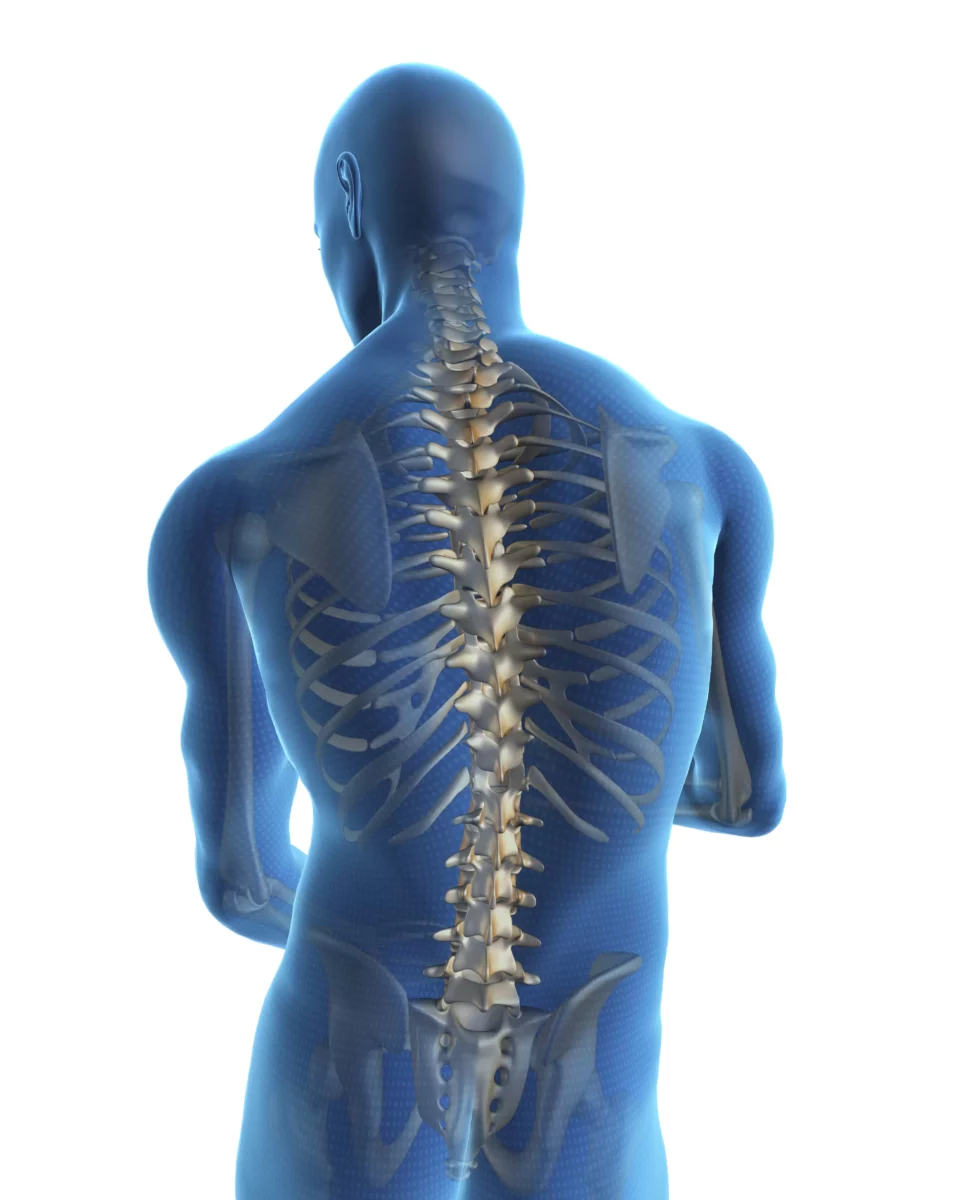
Is is usually caused by degeneration of the vertebrae or disc, due to trauma, injury or genetics. It makes a piece of the spinal bone, also known as vertebrae slips out of alignment and onto the bone below it. Spondylolisthesis usually occurs at the fifth lumbar vertebrae. As reported by the Cleveland Clinic, spondylolisthesis is one of the most common causes of back pain for teen athletes. Having said that, degenerative spondylolisthesis also results in low back pain in people older than 40 years.
Specific spondylolisthesis exercises are suggested to alleviate the pain and discomfort thereby improving the function and quality of life. Let’s now talk about the symptoms of spondylolisthesis.
Symptoms of Spondylolisthesis
Most of the spondylolisthesis symptoms include pain in the lower back that gets worse with standing and hyperextension. The pain may appear like a muscle strain. There are some other symptoms of spondylolisthesis that one must look out for –
• Tightness in hamstring
• Pain in posterior buttock
• Neurological changes including tingling down the legs and numbness
If you are experiencing any of these symptoms or have recently occurred an injury, consult our experienced physiotherapists at our rehabilitation clinics in different locations in GTA.
After a through examination, the physiotherapist suggests a personalised program to help reducing the pain and discomfort caused due to spondylolisthesis. Usually, the physiotherapists classify spondylolisthesis as low grade or high grade, depending on how much the vertebrae have slipped forward. Patients with lesser symptoms and low-grade slips respond well to conservative line of treatment, like exercise. However, patients who experience high grade slips witnessing numbness or tingling in the legs may require surgery.
Considering the potential risks, it is very important to know what exercises must be avoided in spondylolisthesis to prevent further damage or injury.
Spondylolisthesis Exercises to Avoid
If you are looking to rehabilitate a non-operative spondylolisthesis after consulting with the physiotherapist, expect it to take three to six months to heal, according to Sanford Orthopaedics Sports Medicine. It is suggested that the patient must take a break of at least three months from sports and athletics. The patients are also suggested to wear a brace for continuous stretch of time.
Other than rest and bracing, there are many other things to avoid in spondylolisthesis. We are now listing spondylolisthesis exercises to avoid to ensure proper and speedy recovery. These include lumbar extension movements that can take your spine past the neutral position. The lumbar extension movements may increase the pain and slow down the healing of the affected vertebrae.
Some other exercises to avoid in spondylolisthesis include –
- Prone press-ups (Push-up while lying on the stomach)
- Standing extensions
- Prone leg raises (Lifting legs while lying on the stomach)
- Back extension machine at the gym
It is also suggested that yoga asanas must also be avoided in spondylolisthesis. Yoga includes various back extension postures, like cobra and swan pose, which may not be safe to practice in spondylolisthesis.
There are some other exercises that must be avoided in spondylolisthesis. These includes weightlifting, exercises that need you to twist or bend, high impact activities that put a lot of stress on the healing back, like jumping rope or box jumps.
Now that we have learnt what exercises should be avoided for spondylolisthesis, we must also understand are the best to treat spondylolisthesis. Just like all the other injuries, physiotherapy is beneficial in the treatment of spondylolisthesis. Mostly, the rehabilitation focuses on increasing the core muscles without going past neutral along with hamstring stretches. One should expect up three to six months of rehabilitation before returning back to normalcy.
Spondylolisthesis Exercises to Do
We suggest the following spondylolisthesis exercises for a speedy and efficient recovery. We also suggest you to consult with your physiotherapist and not undertake any of these exercises without his approval.
- Pelvic tilt exercises – These exercises help in reducing the discomfort by stabilising the lower spine in a flexed position. Depending upon the pain and your preference, pelvic tilt exercises can be done in various positions.
- Crunches – Patients suffering from spondylolisthesis often face instability and pain caused by weak abdominal muscles. This can be strengthened with powerful crunch exercises. You must try to focus on proper form and moving slowly to engage the core muscles. Spondylolisthesis is a painful condition to be in and therefore we suggest not to force the body to move through full range of motion. This may increase the pain and slow down the recovery time.
- Hamstring stretch – Spinal instability often causes tension in the hamstrings to those suffering from spondylolisthesis. Hamstrings are the large muscles that run down the back of the thigh. Stretching hamstrings sitting on the ground can help to relieve tension and tightness caused due to spondylolisthesis. It also reduces the lower back pain.
- Multifidus activation – Multifidus muscles are the small but very important muscles lying next to the spine. These muscles help in bending and twisting movements thereby increasing the stability of the spinal joints. If suffering from spondylolisthesis, activating multifidi will ease the pain and provide the much-needed comfort.
- Double knee to chest – This spondylolisthesis exercise is suggested to decrease the instability and improve the strength. It works on the core muscles of the torso and is thus beneficial in spondylolisthesis.
Check with your physiotherapist before starting any exercise program for spondylolisthesis while recovering from this injury. You can aim for a gradual return to physical and sports activities, depending on the severity of the injury and how string your core is. Post healing core strengthening is also suggested to prevent future injuries.
Click HERE to book an appointment with a physiotherapist at one of our eight locations.
- Physiotherapy Etobicoke – Triangle Physiotherapy Etobicoke
- Oakville Physiotherapy Clinic – Triangle Physiotherapy Oakville
- Physiotherapy North York – Triangle Physiotherapy North York
- Mississauga Physiotherapy Clinics – Triangle Physiotherapy Mississauga
- Downtown Physiotherapy Clinics – Triangle Physiotherapy King West
- Uptown Physiotherapy Clinics – Triangle Physiotherapy Lawrence Park
- Physiotherapy Clinic Downtown Toronto – Triangle Physiotherapy Queens Quay
- Physiotherapy Clinics Mississauga – Triangle Physiotherapy Erin Mills
For those managing spondylolisthesis, seeking guidance from professional physiotherapists is essential. Whether you are looking for physiotherapy in Etobicoke, Oakville, North York, Toronto, Lawrence Park, Queens Quay, Erin Mills, Mississauga, or Liberty Village, there are specialized clinics available to help you avoid harmful exercises and support your recovery with personalized treatment plans.
Physiotherapy is the study of science of movements. It is a healthcare profession that includes different treatment modalities like massages, electrotherapy, heat therapy, exercises, patient awareness and advice for treating an ailment, deformity or injury.
When should I go to a Physiotherapist?
This is a very common yet important question. If you have suffered an injury or chronic pain that affects your daily chores, then you must consult a good physiotherapist. You can also avail the benefits of physiotherapy after surgery, like knee replacement or stroke.
At Physiotherapy Oakville, we have a team of dedicated and skilled physiotherapists who provide expert care tailored to your specific needs. Scientific research supports the role of physiotherapy in improving recovery outcomes and enhancing overall physical function post-surgery. By joining Physiotherapy Oakville, you gain access to personalized treatment plans and evidence-based practices that help you recover efficiently and resume your daily activities with confidence.
What will a Physiotherapist do?
Our experienced Physiotherapists provide case-based solution to your need. These are focused on preventive as well as rehabilitation. Some scenarios where a good Physiotherapist can help –
- Back and neck pain caused due to sprain in the skeleton or muscles
- Conditions like arthritis or after effects of amputation that results in discomfort in joints, muscles, knees and ligaments
- Lung disorders like asthma or bronchitis
- Disability resulting from heart problems
- Troubles occurred during childbirth like pelvic issue, bladder and bowel problems
- Parkinson’s disease and multiple sclerosis or loss of mobility due to trauma to the brain or spine
- Pain, swelling, fatigue, loss of muscle strength and stiffness during palliative care or cancer treatment
What should I expect from my Physiotherapist?
Our trained Physiotherapists at Triangle Physiotherapy provide specific and concerned answers to your core problems. This is what you can expect from your Physiotherapist-
- Your physiotherapist will understand your medical history
- Based on the medical history and symptoms, the physiotherapist will assess and diagnose your condition
- A treatment module will be set for you for your concern
- Specific exercises and assistive devices would be suggested to you based on your module
To understand what all things are done in Physiotherapy, let’s try to learn the various types of treatment modalities used in Physiotherapy.
- Manual Therapy – This technique is a very common one where the physiotherapists massage the affected joints to mobilise and manipulate using his hands. Our team of expert physiotherapists in Toronto are highly equipped and experienced in this therapy.
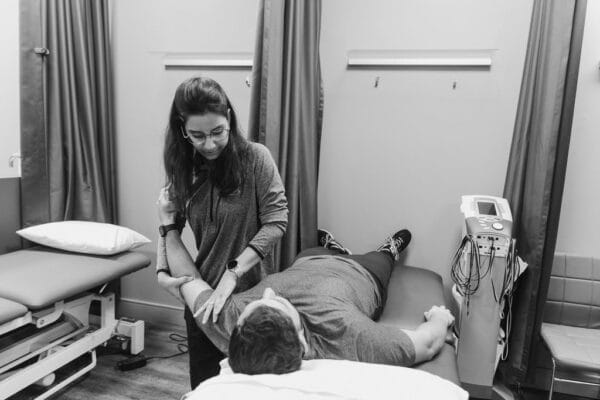
- Transcutaneous Electric Nerves Stimulation (TENS) Therapy – In this therapy, the physiotherapist uses a small device driven by a battery and place it on the skin surface of the patient. Low grade currents are sent through these electrodes to relive pain of the affected area.
- Magnetic Therapy – This therapy uses electromagnets of different sizes and types. These are used to limit the pain of the affected body part.
- Dry needling and acupuncture – In this therapy, the physiotherapist uses fine needles and insert them into specific body parts to alleviate the pain for a short time. You can consult with our physiotherapists at Etobicoke clinic for this specialized line of treatment.
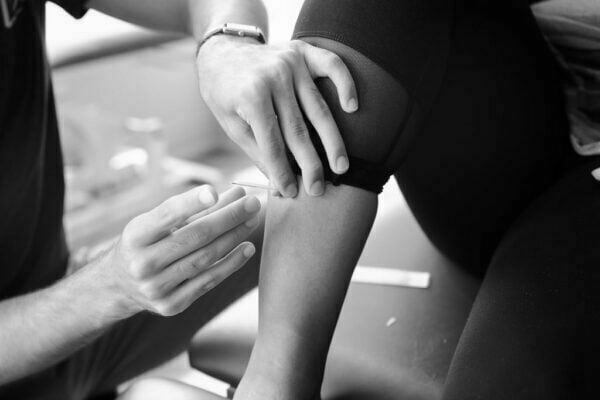
- Taping – This physiotherapy technique is highly popular as it promotes body’s inherent natural healing mechanism. Here, the physiotherapist uses a tape which lifts the skin away from the connecting tissue, thereby increasing the space and allowing the lymphatic fluid to move more functionally to ease the pain.
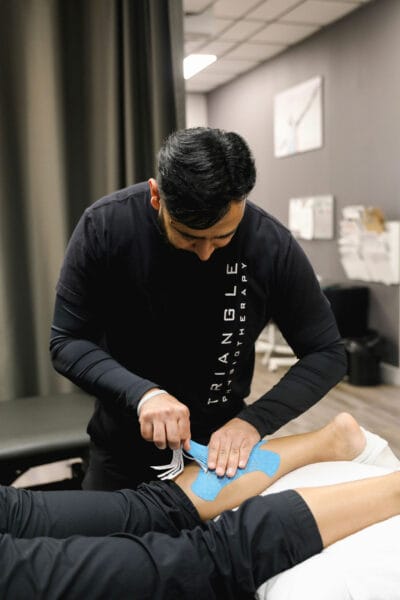
- Joint Mobilisation – This is a manual therapy technique where a physiotherapist mobilises the joint at different depths, speeds and amplitudes. It helps in restoring normal joint movement in the body. Our physiotherapists at Lawrence Park clinic are highly equipped and skilled in this technique.
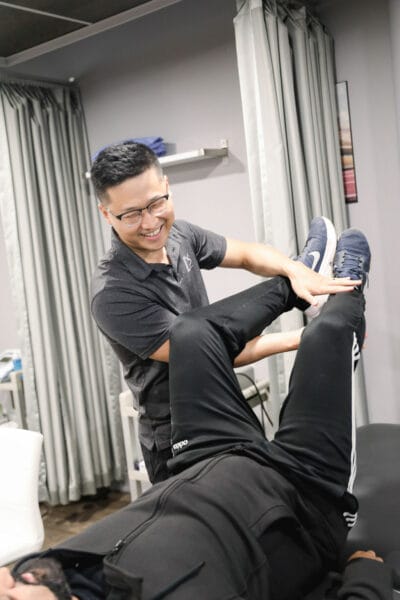
- Stretches and exercises – This is a fairly common module where the physiotherapist teaches different exercises and techniques for body stretching which helps in restoring the joint movements.
- Rehabilitation – This includes a broad range of corrective, preventive and stretching exercises to reduce the sprain or pain in the affected area.
- Strengthening Program – This is one of the most important modalities in physiotherapy where the physiotherapist conducts specific program to make the patient understand about his personal responsibility towards his health and physical conditioning. This program is very useful as it helps the patient in improving overall heath, strength, balance, coordination and flexibility.

- Diathermy – In this technique, electrically induced heat or high-frequency electromagnetic currents are used to relive the pain and cure the condition. Our physiotherapists at North York clinic are efficient and skilled in this technique. If you are facing pain or recovering from a surgery, you can consult us.
- Ultrasound and phonophoresis – A frequency range of 0.5 – 3 MHz is used in this therapeutic ultrasound. This technique induces a deep heat to the target area to treat muscle spasm, promote healing at cellular level and lower the inflammation. It also increases the metabolism and improve the flow of blood towards the damaged tissue. Phonophoresis uses ultrasonic waves for better absorption of drugs that are applied topically during the treatment. This is a very useful technique as it helps in reducing the pain by allowing maximum absorption of drugs like anti-inflammatory and analgesics.
- Range of Motion exercises (RoM) exercises – A good physiotherapist would diagnose the patient and recommend Range of Motion exercises to improve the mobility of joints and reduce the stiffness in the muscles. There are various types of RoM exercises, like Passive Range of Motion (PROM) exercises, Active Assistive Range of Motion (AAROM) exercises and Active Range of Motion (AROM) exercises.
- Soft tissue mobilization – This highly effective technique in physiotherapy helps in alleviating pain, reducing swelling and relaxing the tight muscles in the body.
To summarize, Physiotherapy is a special treatment to maintain, restore and make the most of a person’s function, mobility, strength and well-being. It helps through various techniques and aid in recovery as well as strengthen the body for w holistic living.
Now that we have established what all is done and expected in Physiotherapy, we would like to hear from you. Please write to us if you have any questions regarding Physiotherapy. You can also check our services and locations for any line of treatment.
Click HERE to book an appointment with a physiotherapist at one of our eight locations.
- Physiotherapy Etobicoke – Triangle Physiotherapy Etobicoke
- Oakville Physiotherapy Clinic – Triangle Physiotherapy Oakville
- Physiotherapy North York – Triangle Physiotherapy North York
- Mississauga Physiotherapy Clinics – Triangle Physiotherapy Mississauga
- Downtown Physiotherapy Clinics – Triangle Physiotherapy King West
- Uptown Physiotherapy Clinics – Triangle Physiotherapy Lawrence Park
- Physiotherapy Clinic Downtown Toronto – Triangle Physiotherapy Queens Quay
- Physiotherapy Clinics Mississauga – Triangle Physiotherapy Erin Mills
Physiotherapy encompasses a wide range of techniques, including manual therapy, exercise prescription, and patient education, to promote healing and recovery. For those seeking physiotherapy services, there are numerous clinics available in physiotherapy Etobicoke, Oakville, North York, Toronto, Lawrence Park, Queens Quay, Erin Mills, Mississauga, and Liberty Village. These locations offer expert care and customized treatment plans to help patients achieve optimal health and mobility.
Shoulder Prehabilitation (prehab) involves the process of implementing a physical, psychological, nutritional intervention before an individual goes into surgery. The goal behind prehab programs is to maximize an individual’s physical and psychological fitness/health before surgery in order to reduce pain, increase physical function and allow you to return to your normal activities sooner following surgery.
Although there is limited evidence regarding shoulder prehab programs, there is promising and growing evidence that suggests prehab programs for hip, knee, and spinal surgery may improve pain, function and reduce the total cost of healthcare spending in the post-operative period.
Also Read, Physiotherapy Clinics in Etobicoke
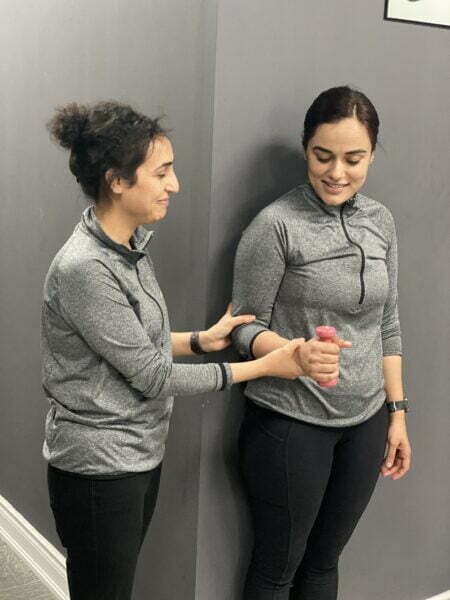
Types of Surgeries for Shoulder
- Reverse arthroplasty
- Total shoulder arthroplasty/replacement
- Rotator cuff repair
- SLAP repair
- Bicep tendon repair
- Tenotomy
What Prehab Programs look like:
Most prehab programs can be anywhere from 2-8 weeks leading up to surgery and could potentially involve:
1) Exercise training (2-3x/week)
- Strengthening and stabilization exercises for the rotator cuff and muscles supporting your shoulder blade
- Home exercise program tailored to your needs
- Exercise training 1 on 1 with a physical therapist
2) Education: information delivered regarding
- Shoulder anatomy and mechanics
- Pain science education
- The process of your operative procedure
- Patient-therapist expectations
- Post-operative protocol
- Detailed exercise program and technique
Also read, Best Physiotherapist near Mississauga
3) Nutritional support
- Consultation with a registered dietician
- Detailed nutrition programs to optimize physical and mental health
- Nutritional supplements as indicated
4) Psychological support
- Consultation with psychologist/ psychotherapist
- Anxiety and stress reduction
- Cognitive-behavioral therapy
- Relaxation techniques
- Coping strategies for surgery
Shoulder Prehab is a set of exercises and movements designed to strengthen and condition the shoulder joint and surrounding muscles, helping to prevent injury or improve recovery from a previous injury. Prehabilitation may include:
- Shoulder rotator cuff strengthening exercises such as internal and external rotation with light weights.
- Scapular stability exercises to improve posture and reduce stress on the shoulder joint.
- Stretching to improve flexibility and range of motion.
- Plyometric exercises to improve power and explosiveness.
- Core stability exercises to improve overall body control and stability.
Prehabilitation should be performed regularly, especially if you have a history of shoulder injuries or plan to participate in overhead activities such as weightlifting or throwing. By taking care of your shoulder before it becomes a problem, you can help prevent injury and improve your performance.
Click HERE to book an appointment with a physiotherapist at one of our eight locations.
- Physiotherapy Etobicoke – Triangle Physiotherapy Etobicoke
- Oakville Physiotherapy Clinic – Triangle Physiotherapy Oakville
- Physiotherapy North York – Triangle Physiotherapy North York
- Mississauga Physiotherapy Clinics – Triangle Physiotherapy Mississauga
- Downtown Physiotherapy Clinics – Triangle Physiotherapy King West
- Uptown Physiotherapy Clinics – Triangle Physiotherapy Lawrence Park
- Physiotherapy Clinic Downtown Toronto – Triangle Physiotherapy Queens Quay
- Physiotherapy Clinics Mississauga – Triangle Physiotherapy Erin Mills
Shoulder prehabilitation is essential for preventing injuries and optimizing recovery, especially for those undergoing surgery or managing shoulder pain. If you’re looking for professional physiotherapy services for shoulder prehabilitation, there are several clinics in physiotherapy Etobicoke, Oakville, North York, Toronto, Lawrence Park, Queens Quay, Erin Mills, Mississauga, and Liberty Village. These locations offer specialized care to help you strengthen your shoulders and maintain overall joint health.
Osteoarthritis (OA) is caused by the wear and tear of the cartilage and can affect all joints in the body. The most commonly affected areas are the knees, hips, low back, neck, and the digits of the hands and feet. Osteoarthritis affects 3.3%-3.6% of the population globally. The risk factors for osteoarthritis include age, gender, weight, anatomy, and history of trauma. The severity of osteoarthritis can be evaluated through medical imaging.
The following are characteristics and clinical presentation of OA:
- Use-related pain
- Stiffness
- Crepitus
- Decrease range of motion and flexibility
- Instability, Weakness
- Deformity
- Swelling
- Local
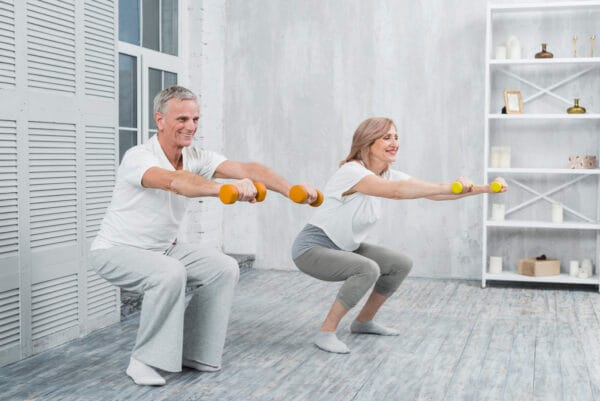
Also read, Best Physiotherapy Clinic in Mississuaga
OA can be managed conservatively through physiotherapy or chiropractic interventions. Pharmacological or surgical intervention may also be of benefit depending on the severity of the joint. Assistive devices can aid in offloading the damaged joint. Physiotherapy and chiropractic treatment for osteoarthritis focuses on reducing pain and increasing physical function through education and exercises. An individualized exercise program consisting of stretching and strengthening the muscles surrounding the affected joint will improve the well-being of the individual.
Tell me more about the GLA:D™ for knee and hip osteoarthritis.
- Good Life with osteoArthritis in Denmark (GLA:D™), developed in Denmark, is an education and tailored neuromuscular exercise program designed for individuals with hip or knee osteoarthritis
- The program is unique because it provides education and targeted exercise that can be applied to movement in everyday activities
- The program is suitable for individuals with early to late stages of OA
The following are the benefits of an individualized exercise program:
- Decrease pain and stiffness
- Increase mobility and function
- Improve muscles length and elasticity
- Improve cartilage
- Reduce risk of injury
- Delay surgical intervention
A physiotherapist and chiropractor can help identify the main issues affecting an osteoarthritic joint and create a treatment program based on your needs and goals.
Contact us today if you would like to see one of our physiotherapists or chiropractors to help you manage your osteoarthritis & relieve your pain.
Click HERE to book an appointment with a physiotherapist at one of our eight locations.
- Physiotherapy Etobicoke – Triangle Physiotherapy Etobicoke
- Oakville Physiotherapy Clinic – Triangle Physiotherapy Oakville
- Physiotherapy North York – Triangle Physiotherapy North York
- Mississauga Physiotherapy Clinics – Triangle Physiotherapy Mississauga
- Downtown Physiotherapy Clinics – Triangle Physiotherapy King West
- Uptown Physiotherapy Clinics – Triangle Physiotherapy Lawrence Park
- Physiotherapy Clinic Downtown Toronto – Triangle Physiotherapy Queens Quay
- Physiotherapy Clinics Mississauga – Triangle Physiotherapy Erin Mills
Managing osteoarthritis effectively requires a comprehensive treatment approach, including physiotherapy to alleviate pain and improve mobility. If you’re looking for professional physiotherapy services to support your osteoarthritis management, clinics in physiotherapy Etobicoke, Oakville, North York, Toronto, Lawrence Park, Queens Quay, Erin Mills, Mississauga, and Liberty Village offer expert care and personalized treatment plans to help you achieve better joint health and quality of life.
Wearing heels may be a fashion statement for some, but for others, it is a work necessity.
Studies have shown that:
- 72% of women wear high heels at some point or the other
- 50% of them wear them at parties
- 39% of them wear them every day
- And 31% of them wear them to work
But wearing heels for a prolonged period of time can lead to multiple issues. So what are the “heel issues” that affect most women? And how can you deal with them?

Also read, Physiotherapy Mississauga
Do your toes hurt and your feet feel numb?
You might have Morton’s Neuroma, commonly known as forefoot pain. People with this ailment most often complain of pain between the 3rd and the 4th toe. Pain between the 2nd and the 3rd toe is less common but also known to happen. This ailment occurs when the nerves between the toes get irritated and inflamed.
Another common issue with wearing high heels is back pain. Constantly wearing very high heels puts stress on the thighs and hip flexors, which in turn puts more pressure on the spine and causes it to curve. The curving of the spine then leads to back pain.
Pain in the knee joints is also an issue that occurs if you wear high heels too often. High heels put too much pressure on knee joints and can create an imbalance in your leg alignment, leading to pain and other issues of the knee joint.
Also read, Physiotherapy Treatment in Etobicoke
Ditching the heels completely will obviously be the best solution. But if you can’t do that, here are some things that you can do –
- Wear heels that are 2 inches or less in height, this will help take off the pressure from your spine and cause less curving.
- If you absolutely must wear very high heels (4 to 6 inches high) one day, wear low to moderate heels the next day. This way your knee joints, spine and thigh muscles will get a break from undue stress.
- If you have forefoot pain, try wearing shoes that are wider around the toes – a shoe with a round or square shape in front is a better choice than a pointy-toed shoe.
- Opt for shoes that have leather insoles so your feet have better grip. Slippery heels cause even more damage to your posture.
- Wear heels for shorter periods of time. The longer you wear high heels, the more damage you cause to your knees and spine.
- Ditch those heels if you are in too much pain. It is better to sit at your desk without your heels on, rather than cringe with pain for the entire day.
- And finally, visit a physiotherapist and do some simple exercises that he or she may suggest to relieve you of your feet, back or knee pain caused by high heels.
At Triangle Physiotherapy our professionals can help you figure out what will be the ideal solution for your ailment. So visit any of our 8 locations of Triangle Physiotherapy clinics – Etobicoke, Oakville, Mississauga, North York, Toronto to heal the issues caused by them heels!
Healing heel pain requires a combination of effective treatments, including physiotherapy to address underlying issues and promote recovery. For professional physiotherapy services to help with heel pain, there are clinics in physiotherapy Etobicoke, Oakville, North York, Toronto, Lawrence Park, Queens Quay, Erin Mills, Mississauga, and Liberty Village. These locations offer specialized care and customized treatment plans to support your journey to pain-free mobility.
Back pain? You are not alone. Over 80 % of Canadians will experience back pain atleast once in their life. However, about 90% of back pain is not caused by any serious injury or disease. That being said, it doesn’t make it any less painful or debilitating. For a lot of people, traditional physiotherapy and massage therapy works well, but if it doesn’t don’t be discouraged… there is still hope! As a physiotherapist myself that has suffered from back pain, yoga has changed my life! It has helped me increase my flexibility, core strength, improve my posture and overall enhance my life.
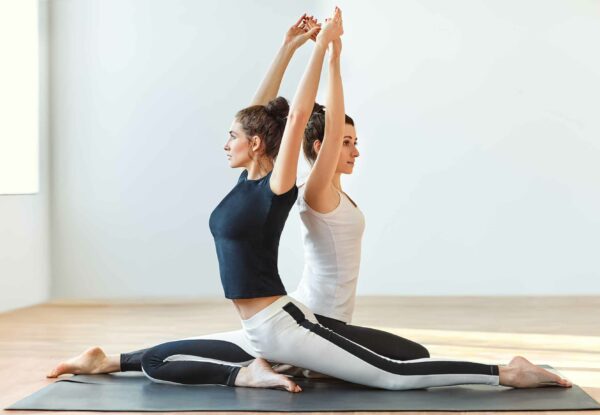
Why Yoga?
1. Stretching
The spine is meant to move in lots of different ways. If we don’t move or stretch it gets stiff and rusty. This can start to cause some aches and pains which can get worse over time if it is not addressed. It can also make you more susceptible to becoming that 10% of people that suffer from a more significant injury. “But it hurts to move,” you say… Yes, oftentimes it does cause some discomfort to move especially if you haven’t tried to move in certain directions for a long time but science now tells us that it is far better for your back to move in a controlled and safe way rather than not moving. This is where yoga can help…. Yoga is a very gentle and proven way to help loosen up your back and make sure it moves smoothly within all its normal ranges of motion.
2. Strengthening
All of us have heard that if you have back pain you should strengthen your core, right? Yoga creates a great way of functionally strengthening your core. What that means is instead of isolating certain muscles, the yoga poses (asanas) that you are taken through will help you learn how to use all the muscles of your core together (including your diaphragm and pelvic floor!). If you continue strengthening your core on the ground then your body doesn’t get stronger in the positions it needs for everyday activities. For example, vacuuming your house requires you to be slightly bent over and pushing/pulling. Yoga poses that can simulate will force you to strengthen your core muscles in the positions it is needed so that once you get stronger, vacuuming won’t be painful.
There are many other benefits of yoga that can help with pain from breathing techniques (if it works for women in labour then it can work for your back pain too!) Also, mind-body awareness and connection is developed to help you realize if there are postures or positions that you are doing out of habit that you don’t realize can be harming your body. Yoga can correct imbalances of your musculoskeletal system that you didn’t even know existed.
Click HERE to book an appointment with a physiotherapist at one of our eight locations.
- Physiotherapy Etobicoke – Triangle Physiotherapy Etobicoke
- Oakville Physiotherapy Clinic – Triangle Physiotherapy Oakville
- Physiotherapy North York – Triangle Physiotherapy North York
- Mississauga Physiotherapy Clinics – Triangle Physiotherapy Mississauga
- Downtown Physiotherapy Clinics – Triangle Physiotherapy King West
- Uptown Physiotherapy Clinics – Triangle Physiotherapy Lawrence Park
- Physiotherapy Clinic Downtown Toronto – Triangle Physiotherapy Queens Quay
- Physiotherapy Clinics Mississauga – Triangle Physiotherapy Erin Mills
Yoga can be a powerful tool for improving back health, enhancing flexibility, and reducing pain when combined with physiotherapy. For those seeking professional physiotherapy services to complement their yoga practice, there are clinics in physiotherapy Etobicoke, Oakville, North York, Toronto, Lawrence Park, Queens Quay, Erin Mills, Mississauga, and Liberty Village. These clinics offer expert care and personalized treatment plans to help you maintain a healthy back and overall well-being.
What is Carpal Tunnel Syndrome?
Carpal Tunnel Syndrome (CTS) is a wrist and hand condition that occurs when a nerve becomes pinched within a tunnel created by the bones of the wrist. The wrist is composed of 8 small bones called Carpals,which, along with ligaments, create a ‘Carpal Tunnel’ on the palmer side of the forearm. This tunnel creates a space for the passage of the Median nerve and theflexor tendons of the fingers. The Median nerve provides both sensory and motor function to the hand, and if it becomes compromised within this space, Carpal Tunnel Syndrome will occur.
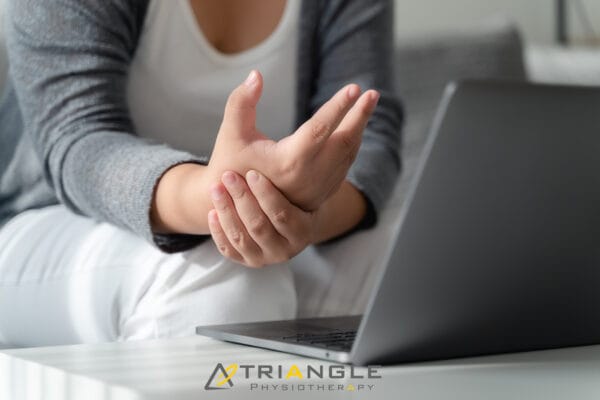
Symptoms:
Symptoms of CTS are numbness, pain, and weakness in the affected wrist and hand. Numbness and pain occur along the sensory distribution of the Median nerve, which includes the palmer side of the thumb, index finger, third finger and lateral half of the ring finger. The progression of symptoms is typically gradual, beginning with itching, tingling or mild burning, and in chronic cases can progress to complete numbness, and involve radiating pain up the arm, decreased grip strength and muscle wasting in the thumb.
Common Causes:
CTS is often due to a combination of multiple factors that result in increased pressure on the Median nerve in the carpal tunnel. This condition is rarely due to an issue with the nerve itself. A common contributing factor to CTS is size of the carpal tunnel, as the smaller the passageway, the greater the likelihood of tendon and Median nerve compression. Women on average have smaller and narrower carpal tunnels then men, making them more prone to CTS. Another contributing factor is injury or trauma to the wrist, because the resultant swelling increases the amount of pressure and decreases the amount of space within the carpal tunnel. Repetitive strain injuries to the wrist can cause inflammation and swelling of the synovial fluid surrounding the flexor tendons, which also decreases the space within the carpal tunnel. These repetitive strain injuries can often occur in the workplace, due to use of vibrating tools and machinery, or repetitive typing and use of a mouse at a computer workstation.
Treatment:
Physiotherapy is often used to help treat Carpal Tunnel Syndrome. Therapy for this condition focuses on proper education about the condition and necessary activity modification, prescription of stretching and strengthening exercises and therapeutic modalities as appropriate. Additionally, bracing can be used to help provide wrist support and stability. Wrist bracing is most effective at night to prevent wrist flexion, and during the day while performing repetitive wrist activities. Occasionally, surgical intervention is required for the treatment of CTS, in which the connective tissue creating the roof of the carpal tunnel is cut to create more room for the Median nerve. Physiotherapy rehabilitation is recommended post-surgery to ensure an optimal outcome.
For more information about Carpal Tunnel Syndrome, ask your physiotherapist at Triangle Physiotherapy and Rehabilitation!
Click HERE to book an appointment with a physiotherapist at one of our eight locations.
- Physiotherapy Etobicoke – Triangle Physiotherapy Etobicoke
- Oakville Physiotherapy Clinic – Triangle Physiotherapy Oakville
- Physiotherapy North York – Triangle Physiotherapy North York
- Mississauga Physiotherapy Clinics – Triangle Physiotherapy Mississauga
- Downtown Physiotherapy Clinics – Triangle Physiotherapy King West
- Uptown Physiotherapy Clinics – Triangle Physiotherapy Lawrence Park
- Physiotherapy Clinic Downtown Toronto – Triangle Physiotherapy Queens Quay
- Physiotherapy Clinics Mississauga – Triangle Physiotherapy Erin Mills
Managing carpal tunnel syndrome effectively often requires physiotherapy to reduce pain, improve hand function, and prevent further injury. If you are seeking professional physiotherapy services for carpal tunnel syndrome, there are clinics in physiotherapy Etobicoke, Oakville, North York, Toronto, Lawrence Park, Queens Quay, Erin Mills, Mississauga, and Liberty Village. These locations provide specialized care and customized treatment plans to help you regain hand strength and mobility.
What is Lateral Epicondylitis?
Lateral Epicondylitis also known as “Tennis Elbow” is the most common overuse injury in the elbow. This injury involves partial or complete tears in the extensor tendons of the forearm muscles causing pain on the lateral (outside) elbow on a region known as the lateral epicondyle.
Anatomy
The elbow joint is made up of three bones: the humerus (upper arm bone), the radius and ulna (two bones in the forearm). On the distal end of the humerus there are two epicondyles, one lateral (on the outside) and one medial (on the inside).
The muscles that extend our wrist are attached to the lateral epicondyle by tendons. These muscles include extensor carpi radialisbrevis (ECRB) extensor carpi radialislongus (ECRL), extensor digitorum and extensor carpi ulnaris. The tears, and subsequent pain, from lateral epicondylitis usually occurs along these tendons. Most commonly the extensor carpi radialisbrevis (ECRB) is injured, but this injury can occur in any of the other muscles mentioned.
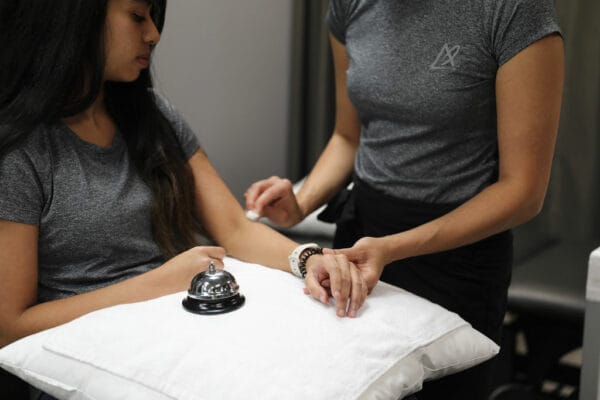
Causes
Lateral epicondylitis usually occurs due to overuse or repetitive movements of the extensor muscles of the forearm. Such an issue can occur due to:
- An over reliance of the extensor muscles because of poor conditioning or injury in the shoulder or upper arm muscles.
- Occupations and nonathletic activities requiring repetitive upper extremity activities and particularly those involving computer use, heavy lifting, forceful forearm pronation (palm face down) and supination (palm face up), and repetitive vibration.
- Improper technique or positioning with equipment i.e. tennis racket.
Risk Factors
While aging is the strongest risk factor associated with lateral epicondylitis, numerous other risk factors have been identified:
-work/non-work related activities requiring repetitive movements,
-training errors,
-misalignments,
-flexibility problems,
-poor circulation,
-strength deficits or a muscle imbalance,
-psychological factors.
Symptoms
- Gradual increase in pain on the lateral aspect of the elbow.
- Weakness in grip strength.
- Worse pain with activities that involve extension of the wrist, e.g. backhand tennis stroke, repetitive use of a screwdriver, or lifting heavy objects.
- In more severe cases, pain can occur with such simple activities as holding a coffee cup or turning a door knob.
Physiotherapy Treatment
There are different types of therapies to treat lateral epicondylitis, all with the same aim: reduce pain, improve function and strengthen the affected muscle. Some of the ways a physiotherapist can help manage and treat your lateral epicondylitis includes:
-Joint Mobilization
– Deep Transverse Frictions
– Modalities – Ultrasound, Electrotherapy, Cyrotherapy, Laser, Extracorporeal Shockwave Therapy
– Orthoses (Bracing)
Exercise Therapy
Stretching – The research and literature shows that strengthening and STRETCHING exercises are the most important components of exercise programmes, for the reason that tendons should not only be strong but also flexible.
Eccentric Exercises
Research has also shown that lateral epicondyitis has shown improvement following treatment utilizing isokinetic eccentric exercise. A great exercise which utilizes this principle is the FlexBar eccentric exercise which has been clinically proven to be effective in providing in improving function with lateral epicondylitis.
Click HERE to book an appointment with a physiotherapist at one of our eight locations.
- Physiotherapy Etobicoke – Triangle Physiotherapy Etobicoke
- Oakville Physiotherapy Clinic – Triangle Physiotherapy Oakville
- Physiotherapy North York – Triangle Physiotherapy North York
- Mississauga Physiotherapy Clinics – Triangle Physiotherapy Mississauga
- Downtown Physiotherapy Clinics – Triangle Physiotherapy King West
- Uptown Physiotherapy Clinics – Triangle Physiotherapy Lawrence Park
- Physiotherapy Clinic Downtown Toronto – Triangle Physiotherapy Queens Quay
- Physiotherapy Clinics Mississauga – Triangle Physiotherapy Erin Mills
Physiotherapy is essential in treating tennis elbow by reducing pain, improving strength, and restoring arm function. If you’re looking for professional physiotherapy services for tennis elbow, there are clinics in physiotherapy Etobicoke, Oakville, North York, Toronto, Lawrence Park, Queens Quay, Erin Mills, Mississauga, and Liberty Village. These clinics offer expert care and personalized treatment plans to help you recover and regain full use of your arm.


